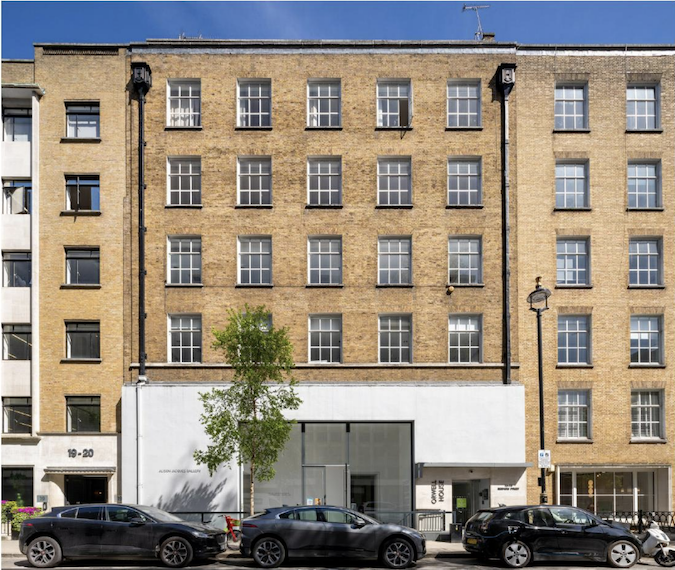As the London property sector awaits a potentially landmark public inquiry ruling about the Marble Arch branch of Marks and Spencer on Oxford Street, a decision has been taken about a low-profile building in Fitzrovia about which some similar issues arose.
The M&S case hinges on whether the building should be refurbished and retrofitted, as environmentalists and conservationists think would be right, or whether it would be better in both commercial and, in the long term, carbon reduction terms to knock it down and build something new, as the retailer maintains.
The fate of Orwell House in Berners Street has been no such cause célèbre. But the deliberations at Westminster Council about its owner’s plans for it nonetheless provided insights into the evolving debate in London planning circles about the respective merits of demolishing old buildings and renewing them.
Berners Street is named after its original developer William Berners, the 18th century slave owner who created a residential area there. In 1809, Number 54 became the focus of a famous hoax. The street was later the base of various charities and medical institutions. Charles Booth, visiting in 1898, noted its musical instrument shops.
It has links with Charles Dickens: it was on Berners Street that the author spotted, as a boy, the woman who would inspire his Miss Havisham character in Great Expectations; a great aunt of Dickens ran a boarding house at Number 16; he would later keep a lover at Number 31. Another literary giant, the poet Samuel Taylor Coleridge, once lived at Number 71.
Orwell House is at Numbers 16-18. It’s a seven-storey London stock brick office block with a retail art gallery, wedged between Berners Street and the parallel Berners Mews. The unlisted building was put up in two phases, one in the 1930s, the other in the 1950s. It was bought in 2020 by Kajima Europe, a subsidiary of the Kajima Corporation.

According to Fitzrovia News, Kajima has “now decided it is bored with its purchase and wants to knock it about”. Kajima itself pitched its proposals rather differently when they went out for consultation last autumn, describing “emerging plans that would seek to refurbish and extend Orwell House in order to deliver sustainable and flexible office accommodation which will appeal to a diverse occupier base”.
Westminster Council’s Director of Town Planning and Building Control summarised the application as follows:
“Partial demolition, refurbishment and extension of the existing building comprising removal of the Berners Street facade and stepped rear extensions at third to seventh floor levels; creation of external terraces; removal of existing mews storage unit and infilling to mews building; recladding of facades; installation of new plant equipment; new cycle parking and facilities; and associated works.”
A mixture, then, of refurbishment, rebuilding and enlargement. A wider range of activities is envisaged too, with the gallery and offices joined by shops and a wine bar. This seems to be in line with a general, post-Covid trend for workspaces to be designed with sociability in mind, perhaps helping to make working in the office that little bit more appealing than working from home.

Certainly, the director’s report thinks the current gallery’s “dead frontage” – there is no art on display for passers by – would be enlivened by some new combination of gallery, shops and places to eat and drink. “It is considered that there would be a considerable improvement to the site’s engagement with the street,” the report says.
The Fitzrovia West Neighbourhood Forum, applauded some aspects, including an “excellent” standard of water use efficiency. But the forum would have preferred a full refurbishment approach and didn’t want a wine bar there. It was concerned that “a number of small media and design businesses would be lost” and that the current gallery will be “displaced”. And it warned that the site was “in danger of being over-developed”.
Fitzrovia News had already been rather blunt: “The outline plans put forward by Kajima and its team would make the building unrecognisable and would appear to be an environmentally damaging demolition and wholesale redevelopment of the site rather than the greener refurbishment they claim it to be.”
But last Tuesday, the director recommended Kajima’s plans for approval, subject to a financial contribution of £90,481 towards the council’s carbon off-set fund. This has been set up to receive contributions from developers whose projects are, as the council puts it, “unable to fully meet the carbon savings required at the development site”. Payments to the fund are “determined by the amount of residual carbon to be offset. The fund is then used to finance carbon-saving projects elsewhere in Westminster”.
A comprise, then, if you like, which members of Westminster’s major planning applications sub-committee discussed in terms of the retrofit-demolition trade-off involved, with some worries aired about the wine bar becoming a source of late night antisocial behaviour. But in the end they voted unanimously to approve.
As for the big M&S decision, that is now not expected before 20 July. Michael Gove, it seems, needs a bit more time.
Twitter: Follow On London and Dave Hill.
On London and its writers need your help with providing seriously knowledgable coverage of the UK capital’s politics, places and people. Give £5 a month or £50 a year and, along with our gratitude, you will receive my weekly newsletter On London Extra and (at no additional charge) invitations to events featuring eminent Londoners. You can pay using any of the “donate” buttons on the site, by becoming a paid subscriber to my Substack, or directly into my media empire’s bank account. Email davehillonlondon@gmail.com for details. Thanks.

